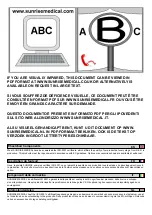
ENGLISH
16
Life R Rev.2.0
Brake Lever Extension
The longer lever helps to minimise
the effort needed to set the wheel
locks.
The brake lever extension is
screwed to the brakes. By raising
this, it can be flipped forward
(Fig. 6.5).
CAUTION !
Mounting the wheel lock too close
towards the wheel will result in a higher effort to operate. This
might cause the brake lever extension to break!
Leaning onto the brake lever extension while transferring will
cause the lever to break! Splashing water from tyres might
cause the wheel lock to malfunction.
CAUTION !
Incorrect mounting of the wheel
lock will result in a higher effort to
operate.
This might cause the wheel lock
extension lever to break.
Compact Brakes
Compact brakes are underneath
the seat sling and are operated by
pulling the brakes towards the rear,
in the direction of the tyre. For the
brakes to work properly, this must
be pulled until it reaches the stops, (Fig.6.6).
Fig. 6.5
Fig. 6.6
Drum Brakes
Drum brakes permit safe and convenient braking for an atten-
dant. They can also be set with the aid of a locking lever (1) to
prevent rolling. This lever must snap audibly into place. Drum
brakes do not independent on the aid of air pressure inside the
tires. Your wheelchair cannot be moved when the drum brakes
are set, (Fig.6.6.1).
Fig. 6.6.1
1
Brakes
Wheel Locks
(Fig.6.01-6.02)
Your wheelchair is equipped with
two wheel locks. They are applied
directly against the tyres. To
engage, press both brake levers
forward against the stops. To
release the locks, pull the levers
back to their original positions.
WARNING!
Braking power will decrease with:
•
Incorrect fitting and adjustment
of the brakes.
•
Tyre pressure too low.
•
Worn tyre tread
•
Wet tyres
•
Improperly adjusted wheel locks.
•
The wheel locks have not been
designed to be used as brakes
for a moving wheelchair.
•
The wheel locks should
therefore never be used to brake a moving wheelchair.
•
Always use the hand-rims for braking.
Make sure that the gap between the tyres and wheel locks
complies with given specifications. To re-adjust, loosen the
screw and set the appropriate gap. Then re-tighten the screw
(Fig. 6.01, 6.02).
After each adjustment of the rear wheels, check the wheel lock
gap and re-adjust if necessary.
Fig. 6.01
Fig. 6.02
3 mm
Standard brake
Standard brake
1
10-15 mm
Fig. 6.03
Fig. 6.03.1
















































